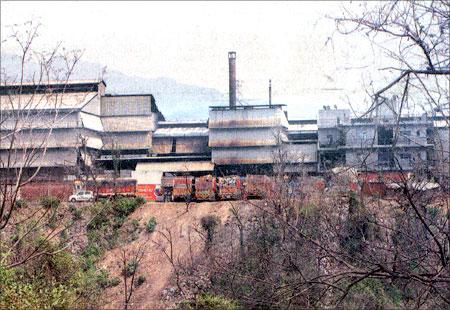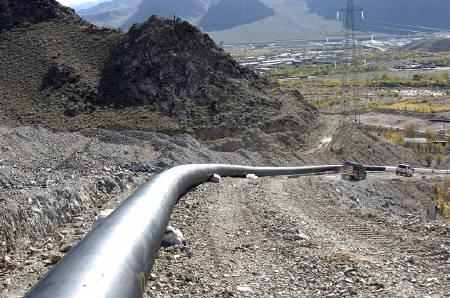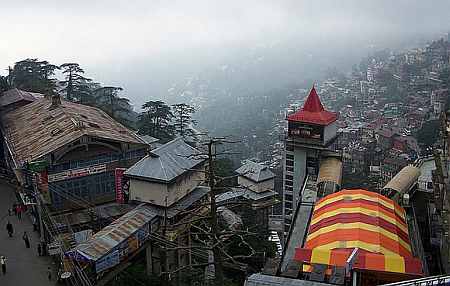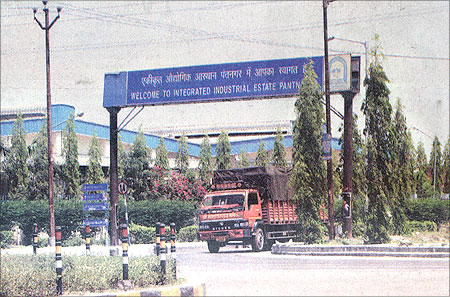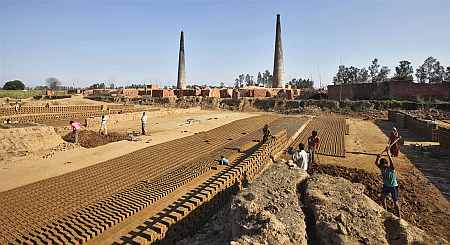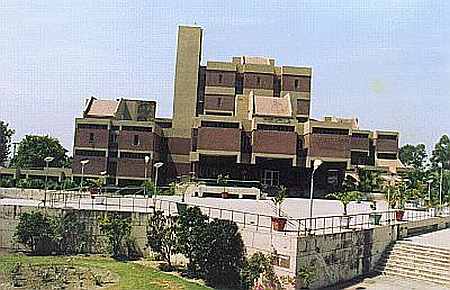 | « Back to article | Print this article |
How Uttarakhand is different from Himachal Pradesh
Tax sops were announced for factories set up in hill states in 2001. A decade later, Rudrapur in Uttarakhand is a well-planned industrial town, while Baddi in Himachal Pradesh shows signs of haphazard development.
Driving up from Chandigarh, as the road curves around the Siswan dam, Kasauli, the colonial hill station, comes into view. Behind it and higher up rests the Raj's summer capital, Shimla. Underneath these hills, white smoke rises from cluttered shoebox-like structures, randomly spread across the foothill.
Here, between forest and hill, lies the industrial township of Baddi, the pharmaceutical capital of India -- every drug-maker worth its penicillin is here: Ranbaxy, Abbott, Dr Reddy's, Cipla and Zydus Cadila.
As you drive in, the topography becomes plain and the air dusty. The roads are bumpy, as thousands of trucks move into the industrial belt of Baddi, Nalagarh and Barotiwala, spread over 315 square kilometres.
Click NEXT to read more...
How Uttarakhand is different from Himachal Pradesh
Commercial vehicles have to wait in an hour-long queue to pay the state road tax before they can enter Baddi. However, you can jump the queue -- all it takes is a bribe of Rs 50. At noon, the town looks deserted.
Construction seems to have paused with half-complete buildings strewn all over. There are very few vehicles, except trucks parked in the bay area. A frail-looking Home Guard, directing the odd vehicle, is the only visible sign of administration. Yet, Baddi is home to over 2,000 industrial units which employ around 200,000 people.
In the 11 years since the National Democratic Alliance government announced tax breaks in 2001 for companies that invested in the northern hill states of Jammu & Kashmir, Himachal Pradesh and Uttarakhand, Baddi has changed beyond recognition.
The plain fields here are fed by seven river streams. Earlier, in the rainy season, there would be frequent floods and Baddi would be cut off from the rest of the world.
Click NEXT to read more...
How Uttarakhand is different from Himachal Pradesh
Rajesh Guleria, who has been working in Baddi since 1997 at a unit that makes industrial lubricants, recalls that reaching the factory itself used to be a challenge: "Till the late 1990s, we would wait during the monsoons for the water to recede as there were no bridges."
All that is distant memory. Yet, there are visible gaps. Most roads inside the town have a single lane and are too narrow for large trucks. People here are still awaiting a four-lane highway between Kalka and Baddi.
The road, which passes through Punjab, Haryana and Himachal Pradesh, seems to have fallen between three stools. "In one of the meetings with the Haryana chief minister [Bhupinder Singh Hooda] we were told it was not in Haryana's interest to build the road as it will lose investments to Himachal," a local industrialist says, requesting anonymity. Industry here has been demanding a rail link for over a decade, but that remains a distant dream.
Click NEXT to read more...
How Uttarakhand is different from Himachal Pradesh
The demand for a gas pipeline, which would cut fuel costs for industrial boilers used widely in pharmaceutical units, too has not been met.
To take care of the infrastructure constraints and develop Baddi in phases till 2025, Centre for Environment Planning and Technology, Ahmedabad, was commissioned to draw up a master plan for the township.
The master plan was submitted to the Himachal government in 2009, but a decision is yet to be taken. Most district officials sit more than two hours away in Solan. As a result, the signs of unplanned development are plentiful.
Despite the rapid development, the town has failed to develop a social infrastructure. Baddi does not boast of a reputed school. It lacks a hospital of any consequence. Despite being in a high-risk seismic zone, there are no disaster management centres.
Click NEXT to read more...
How Uttarakhand is different from Himachal Pradesh
The town's fire station lacks the capability and manpower to fight industrial fire. There is hardly any park or shopping centre, and after 11 years of the tax sops there is just one cinema hall.
With these deficiencies, most people working in Baddi -- labourers, clerks as well as officers -- prefer to stay in neighbouring Chandigarh and Panchkula. As a result, the real estate boom has passed by Baddi. Sitting in his two-room office in the centre of Baddi, 30-year-old property broker Mahendra Kumar greets visitors with a handshake and then offers tea.
"Land rates will only go up here," Kumar reassures his customers. His words are well-rehearsed. Privately, his advice is different: "Don't even think of investing here. People who bought flats at around Rs 15 lakh in 2008 are coming to me to find them buyers willing to pay Rs 12 lakh." Similarly, of the 37 hotels that have come up in the last decade or so, six have closed down and a few are looking for buyers.
Click NEXT to read more...
How Uttarakhand is different from Himachal Pradesh
The tax breaks were available for units set up until 2011, and factories can claim these till 2021. This makes locals as well as investors worry about the future of their town and their investments. P L Negi is an economic investigator at the Single Window Clearance Agency.
His small four-room office looks empty. Bustling with activity till a couple of years ago, there are no investors here now. Negi is surprisingly frank: "Investments have come down."
Though no big companies have moved out, he says, "after 2013, the number of companies here will be much less."
Click NEXT to read more...
How Uttarakhand is different from Himachal Pradesh
Negi admits that the government didn't do much to help the cause either. "No one in the government had expected so many investments in one go." The nature of the units here is also worrisome: what does it take for a pharmaceutical company to shut shop, load its equipment on a truck and move to the next tax haven?
Industrialists here say the future of Baddi looks bleak because the government did not plan its development. Most here cite Uttarakhand, which received similar tax benefits, as an example for the Himachal government to learn from. "In Baddi, the development was haphazard," laments Arun Rawat, president of Baddi Barotiwala Nalagarh Industries Association.
"Look at Uttarakh#8743 there the government first developed land and then called industry." Rawat's sentiment finds echo across Himachal. "In Uttarakhand, the development was much more planned," says C N Dhar, senior vice-president, Indo Farm Equipment.
Click NEXT to read more...
How Uttarakhand is different from Himachal Pradesh
"Once during a meeting I was told by senior state government officials that they were unable to match development with growth because they were taken with surprise by the amount of investments coming in."
In 2002, 40-year-old Kuldeep Singh wanted to leave Rudrapur and move to a bigger city. Rudrapur then was a sleepy Terai town that you would cross on the road to Nainital in not more than a couple of minutes. Prosperous Sikh farmers from villages around came here to get their motorcycles and tractors repaired. An air of laziness hung over the town.
"There wasn't much work here then," says Singh who now drives a cab around Rudrapur and Pant Nagar for a living. "Delhiwallasi have changed Rudrapur," he says, pointing to the town's growth in the last 10 years.
Click NEXT to read more...
How Uttarakhand is different from Himachal Pradesh
"My house, which was worth nothing, is now valued at Rs 25 lakh." Factories here are large and uncluttered. Hotels have mushroomed and roads have been broadened, though it now takes half an hour to exit the town. Signposts, white letters on green luminescent boards, are aplenty. Shops have turned glitzy.
Though it was entitled to the same tax breaks as Baddi, industry discovered Rudrapur later. (The town is named after King Rudra Chand of Kumaon.) That's because the Uttarakhand government developed the basic infrastructure first and then called industry.
The town was chosen for its inherent advantages such as availability of a railway link, a working airport, abundance of plain land and direct road connectivity to the rest of the country. While, in Baddi, industry had to buy land directly from locals, in Pant Nagar the government made land available. To avoid trouble from farmers, around 3,500 acre of land was leased from Pant Nagar University.
Click NEXT to read more...
How Uttarakhand is different from Himachal Pradesh
A decade later, the signs of planned development are all over. Unlike Baddi, the mood here is optimistic. People appear more confident of development and don't complain about government apathy.
The industrial area, unlike Baddi, looks planned with roads that are wide and symmetrically designed. There are around 432 companies here. These include automobile majors Ashok Leyland, Tata Motors and Bajaj Auto, FMCG companies such as Dabur and Nestle, IT companies HCL and HP, and white-goods manufacturer Voltas.
To ease access to industry, the government has shifted all important departments to the industrial area. These include the offices of the district magistrate and police chief.
Click NEXT to read more...
How Uttarakhand is different from Himachal Pradesh
The effect on the town's ecosystem is visible. The hospitality sector has shown robust growth from just a couple of hotels in early 2000 to over 100 in 2012. The town now has a newly-constructed five-star hotel, Radisson Blu.
Next to the hotel, residents of the town keenly await their first shopping mall and multiplex. Real estate prices have zoomed from around Rs 8 lakh an acre in 2000 to over Rs 1.5 crore (Rs 15 million) an acre today.
Housing societies have come up in large numbers with national developers such as Omaxe, Supertech and Assotech building 1,400 apartments on 100 acres of land. "Around 70 per cent of our homes have been sold. Most of the buyers are employed in the industrial area," says Mahesh Dutt, manager (sales and marketing) at Metropolis City, which has "aesthetically designed vaastu-friendly" apartments with swimming pool, health club and spa.
Click NEXT to read more...
How Uttarakhand is different from Himachal Pradesh
The social infrastructure in Pant Nagar is sound. The town has one of the country's oldest universities, the Govind Ballabh Pant University of Agriculture and Technology; new private engineering and management colleges have also come up.
But more needs to happen. Though the town has many private clinics, there is no big hospital. It also lacks a reputed school and an industrial training institute to meet the demand for skilled workers.
Those who can afford to, send their children to boarding schools in Nainital. Electricity, available in abundance earlier, is also running in short supply with five to six hours of power cuts every day. Still, people working in the factories prefer to stay here.
Click NEXT to read more...
How Uttarakhand is different from Himachal Pradesh
Also there is no visible fear of industry deserting the town once the special package ends. To some extent the reason lies in the nature of the factories set up here. Unlike Baddi, engineering and FMCG companies have set up large factories in Pant Nagar, which cannot relocate easily.
More significantly, a large number of ancillary units have come up in the area to serve the large factories; these will act as roots that will hold the investments in Rudrapur. Deepak Dhoundiyal, a first-generation entrepreneur who left his job in Escorts to start his company, is confident that the boom will not peter out soon.
His company, Avance Bussol, supplies parts to Ashok Leyland and Tata Motors. "Until now most small parts came from units based out of Pune and Faridabad. But parts are being sourced from here now, which cuts transportation costs," says he. Dhoundiyal has bet on the future. The risk, he is confident, is minimal.
